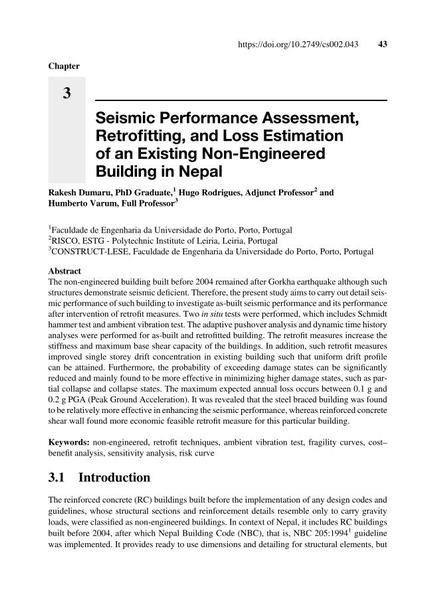Seismic Performance Assessment, Retrofitting and Loss Estimation of an Existing Non-Engineered Building in Nepal

|
|
|||||||||||
Détails bibliographiques
| Auteur(s): |
Rakesh Dumaru
(Faculdade de Engenharia da Universidade do Porto, Porto, Portugal)
Hugo Rodrigues Humberto Varum |
||||
|---|---|---|---|---|---|
| Médium: | chapitre de livre | ||||
| Langue(s): | anglais | ||||
| Publié dans: | Case Studies on Conservation and Seismic Strengthening/Retrofitting of Existing Structures | ||||
|
|||||
| Page(s): | 43-70 | ||||
| Nombre total de pages (du PDF): | 28 | ||||
| Année: | 2020 | ||||
| DOI: | 10.2749/cs002.043 | ||||
| Abstrait: |
The non-engineered building built before 2004 remained after Gorkha earthquake although such structures demonstrate seismic deficient. Therefore, the present study aims to carry out detail seismic performance of such building to investigate as-built seismic performance and its performance after intervention of retrofit measures. Two in situ tests were performed, which includes Schmidt hammer test and ambient vibration test. The adaptive pushover analysis and dynamic time history analyses were performed for as-built and retrofitted building. The retrofit measures increase the stiffness and maximum base shear capacity of the buildings. In addition, such retrofit measures improved single storey drift concentration in existing building such that uniform drift profile can be attained. Furthermore, the probability of exceeding damage states can be significantly reduced and mainly found to be more effective in minimizing higher damage states, such as partial collapse and collapse states. The maximum expected annual loss occurs between 0.1 g and 0.2 g PGA (Peak Ground Acceleration). It was revealed that the steel braced building was found to be relatively more effective in enhancing the seismic performance, whereas reinforced concrete shear wall found more economic feasible retrofit measure for this particular building. |
||||
